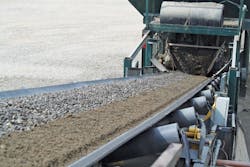By: Tom Kuennen; Contributing Author
A two-lane blacktop road in Cortland County, N.Y., benefited from a sophisticated pavement preservation overlay that combined two lifts and two types of cold mix pavement that are anticipated to provide a high level of service in the years to come.
It’s no secret that local government agencies across the U.S. have been forced to do more with dwindling resources. They have been charged with finding new, innovative ways to repair and maintain their transportation infrastructure at a lower cost, as the high costs alone of previous practices make system rehabilitation unsustainable.
In recent years, a need to rehabilitate the Truxton-Tully Road in Cortland County was identified, and was selected to be a full road reconstruction project, completed with costly land acquisitions, structural improvements and a hot-mix asphalt (HMA) binder and wearing layer.
After realizing there were not enough funds to complete the project as first envisioned, combined with a change to the federal-aid project criterion enacted by the Federal Highway Administration, a completely new approach was undertaken to deciding how to best address the issues with Truxton-Tully Road.
Local and state officials applied the New York State Department of Transportation’s (NYSDOT) Forward Four philosophy to the project, an applied system by which projects are matched via four qualifying criteria:
- The project must benefit the overall transportation system;
- It must focus on pavement preservation;
- It must optimize return on investment; and
- It must meet strict sustainability guidelines.
During construction, crews utilized a portable mixing unit (pugmill) equipped with a split-bin hopper and calibrated belt scales to produce the dense-graded cold mix material.
Subsequent to ironing out funding mechanisms, officials from Cortland County and engineers from a locally based contractor, Suit-Kote Corp., worked together to find a solution that would use alternative products and material formulations, resulting in a safe, durable roadway capable of achieving the same lifecycle as other more costly, conventional processes.
A chip seal wearing course utilizing high-float rapid-set, polymer-modified surface treating emulsion (HFRS-2P) and NYSDOT-approved 1A-sized aggregate was placed.
Eventually the project was funded with 80% federal (MAP-21 and STP-Flex funding), 13% state of New York (Marchiselli funding) and 7% Cortland County funds. The cooperative planning approach that resulted from this multiprong funding scenario also allowed for creative solutions to drainage and safety improvements, as well as new guiderail installation, without the need for an overhaul to the original design.
High-float emulsions
Although it was new to NYSDOT, Suit-Kote decided to propose a process it had perfected in many counties and local communities across New York. For the binder course, it proposed to use a dense-graded cold mix utilizing a high-float, medium-set, hard-based asphalt emulsion commonly referred to as HFMS-2GH, with a top course consisting of a similar dense graded cold mix, but with smaller aggregate for a smoother, tighter finish.
Work crews would return to the project later to install a surface-treatment wearing course that consisted of an application of high-float rapid-set, polymer-modified surface treating emulsion (HFRS-2P) and NYSDOT-approved 1A-sized aggregate.
What set this particular process apart from others is that the HFMS-2GH contains 70% residual asphalt content, whereas conventional medium-set emulsions contain only 65%, thus promoting maximum adhesion, flexibility and coating.
Cortland County officials embraced this alternate plan utilizing a special specification section of the regulations and presented it to the NYSDOT Region 3 materials engineer’s office. This new cooperative effort of a private company along with state and local government officials proved to be a groundbreaking partnership. This alternate strategy was accepted and the project was let for public bid in late May 2015.
Suit-Kote was awarded the project, with a notice to proceed with construction operations set to begin in late July, and a planned completion date in the early weeks of September.
Getting down to work
Construction crews began the project by removing various concrete headwalls along the 5.7-mile stretch of Truxton-Tully Road and replacing them with closed drainage systems. This early process was done to enable adjacent slopes to be graded to proper guiderail standards, and eliminate the hazards of a concrete headwall.
In addition to specific closed drainage improvement, crews replaced a majority of the residential driveway pipes and reshaped the existing ditch lines, in accordance with the contract specifications, in an effort to improve drainage throughout the length of the project.
The dense-graded cold mix was manufactured off-site at a nearby quarry and applied in mid-August using conventional paving techniques. As this road originally was constructed over a frost-susceptible sub-base, dense-graded cold mix was the product of choice, because if cracking occurs, it will “heal itself.”
The mixture gradation for binder and surface mixes was very similar to Superpave 19 mm and 12.5 mm. During construction, the contractor utilized a portable mixing unit (pug mill) that was equipped with a split-bin hopper and calibrated belt scales to produce the dense-graded cold-mix material, along with a conventional hot-mix paver with slight modifications, such as wider screed plates and a modified angle of attack.
The aggregate for the production of the cold-mix pavement consisted of virgin stone, mined and processed at a local quarry. A percentage of aggregate was reclaimed from stockpiled asphalt millings generated from local NYSDOT pavement improvement projects.
Nearly 25,000 tons of material was delivered in 20-ton loads from the pug mill at the quarry to the project location, approximately 14 miles away, via tri-axle dump trucks. The cold-mix pavement was placed with a conventional Cat AP1000D asphalt paver and compacted with two traditional double-drum vibratory rollers.
In the process, crews found it important to hold the rollers back from the paver in order to enhance the mix cure and set characteristics. After compaction, the paving course was ready to accept traffic much like conventional hot-mix paving.
Once the placement of the cold-mix pavement was complete, 1,900 tons of shoulder backup was installed to complete the grading of the roadway section.
Prior to the application of the surface-treatment wearing course, the contractor was required to replace substandard guiderail throughout the project and install new signs. This work was completed by subcontractor EMI Guiderail Co. Inc.
Topped up
The final phase of the project was the surface-treatment wearing course, or chip seal. This process was ultimately chosen because it offered the most cost-effective and durable wearing solution. By using a high-float polymer-modified asphalt emulsion, it allowed for quicker adhesion and increased aggregate retention.
A dense-graded cold mix utilizing a high-float, medium-set, hard-based asphalt emulsion is placed on Truxton-Tully Road in Cortland County, N.Y.
Like any construction project, there are often unforeseen variables to deal with, and they can add to the overall cost of the project. It’s not uncommon for cost overruns to be significant, but because of the unique mix of specified processes and interagency cooperation, the Truxton-Tully Road project was completed on time and on budget.
For the first time in New York State history, a federally funded total reconstruction project was converted to a cost-effective preservation project that instead utilized dense-graded cold-mix asphalt with an enhanced HFMS-2GH asphalt emulsion, consisting of 70% asphalt. In the end, this project represented a win for cooperation between the private and public sectors, but most of all, was a resounding victory for the taxpayer. AT
About The Author: Kuennen is a principal at Expresswaysonline.com.





